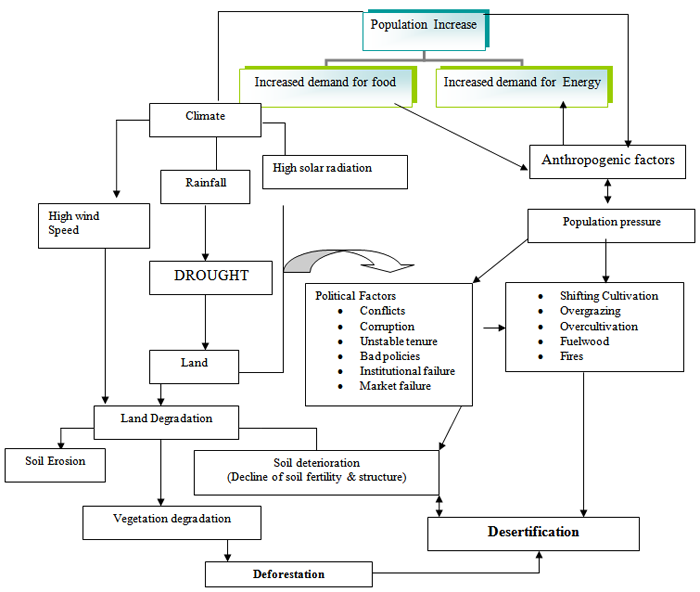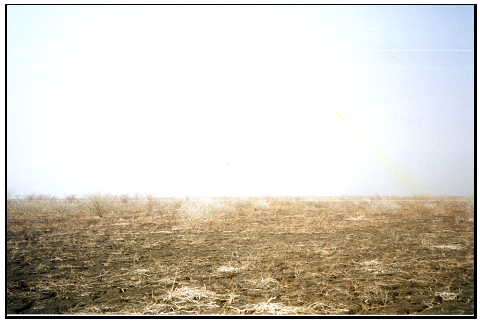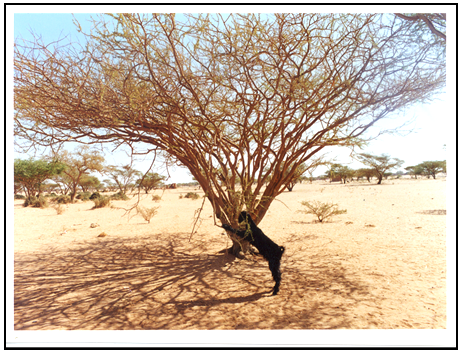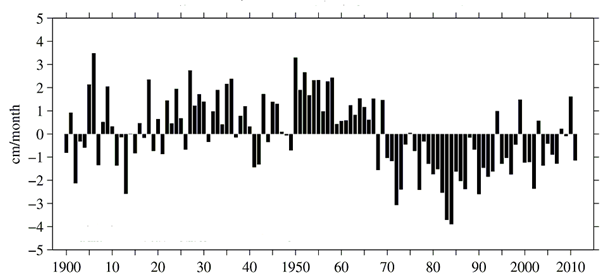-
Paper Information
- Next Paper
- Previous Paper
- Paper Submission
-
Journal Information
- About This Journal
- Editorial Board
- Current Issue
- Archive
- Author Guidelines
- Contact Us
International Journal of Agriculture and Forestry
p-ISSN: 2165-882X e-ISSN: 2165-8846
2013; 3(2): 40-51
doi:10.5923/j.ijaf.20130302.03
Causes and Impacts of Land Degradation and Desertification: Case Study of the Sudan
Omar A. Abdi1, Edinam K. Glover2, Olavi Luukkanen1
1Department of Forest Sciences, Viikki Tropical Resources Institute, P.O. Box 28, FI- 00014 University of Helsinki, Finland
2Faculty of Law, P.O. Box 4, FI – 00014 University of Helsinki, Finland
Correspondence to: Edinam K. Glover, Faculty of Law, P.O. Box 4, FI – 00014 University of Helsinki, Finland.
| Email: |  |
Copyright © 2012 Scientific & Academic Publishing. All Rights Reserved.
Desertification, a phenomenon referring to land degradation in arid, semi-arid and dry sub-humid regions as a result of climatic variations and human activities, is considered as one of the most severe environmental and socio-economic problems of recent times. The principal aim of this study was to explore the impacts of desertification, degradation and drought on both the natural resources and man's livelihood in the Sudan and to suggest appropriate forest resource management interventions. The study was based on a fact finding tour in the Sudan and data collection on drought trends as reflected in rainfall trends in the study area, and on trends concerning the productivity of natural resources. Information was also compiled from existing records on rainfall, forest land cover, forest stocking, rangelands and carrying capacity and on agricultural productivity and population trends. Results showed that in rain-fed agricultural zones in the Sudan, deep ploughing and leveling of the surface soil caused an increase in its susceptibility to wind erosion, which, in turn, has led to a severe decline in its fertility and, in some places, the formation of sand dunes. The implications of these trends on the natural resource base include environmental degradation, food insecurity and aggravation of income inequalities among the Sudanese producers. The study has suggested Agroforestry technology as a potential solution to this continued problem of declining rural agricultural production in the Sudan.
Keywords: Agroforestry, Desertification, Drought, Drylands, Natural Resources, Rainfall Trends, Sudan
Cite this paper: Omar A. Abdi, Edinam K. Glover, Olavi Luukkanen, Causes and Impacts of Land Degradation and Desertification: Case Study of the Sudan, International Journal of Agriculture and Forestry, Vol. 3 No. 2, 2013, pp. 40-51. doi: 10.5923/j.ijaf.20130302.03.
Article Outline
1. Introduction
- The term Sahel (an Arabic word for shore) is used to refer to the semi-arid zone to the south of Sahara desert. It is one of the world’s warmest regions, with a short summer rainy season of three months[1,2]. Climatologically, the Sahel is characterized by frequent droughts - low, poorly distributed and highly variable monthly and seasonal unpredictable rainfall. Arid, semi-arid and dry sub-humid zones are characterized by, low and erratic rainfall that does not exceed 700mm per annum, periodic droughts, and different combinations of vegetational cover and soils. Inter-annual rainfall varies from 50-100% in the arid zones of the world with averages of up to 350 mm. In the semi-arid zones, inter-annual rainfall varies from 20-50% with averages of up to 700 mm. Regarding livelihoods systems, generally speaking, light pastoral use is possible in arid areas whilst rain-fed agriculture is not usually possible. In semi-arid areas agricultural harvests are likely to be irregular, although grazing is satisfactory[3,4]. The dry sub-humid areas receive higher amounts of rainfall than the other categories of drylands which can reach more than 800 mm annually. Drylands are characterized by high maximum temperatures and large temperature differences between day and night. Other climatic characteristics include strong winds, and low humidity. These are reflected in an increased vapour pressure deficit with implications for water use efficiency, transpiration, and evaporation.Drylands are frequently subjected to drought which is the main limiting factor on biomass production and crop yields. Human induced factors such as overcultivation, overgrazing and other forms of inappropriate land use, when practiced under the conditions prevailing in the drylands, may result in significant degradation of vegetation and, soil leaching and in many cases, in desertification[5].Against this backdrop, this study was conducted to explore the impacts of desertification, degradation and drought on both the natural resources and man's livelihood in the Sudan. Data for this study was derived from both primary data (observation) and secondary data or a review of relevant literature, and a compilation of other available information on drought trends as reflected in rainfall trends in the study area, and on trends concerning the productivity of natural resources in the wider context of land degradation and desertification. Information was also compiled from existing records on rainfall, forest land cover, forest stocking, rangelands and carrying capacity and on agricultural productivity and population trends.
2. Dryland Problems
- Many drylands show clear evidence of environmental degradation. Drought and unreliable and variable rains are a recurrent problem. Even without climate change, the drylands face a daunting array of threats including population pressure, social changes such as the settlement of traditionally nomadic peoples, and exploitive agricultural and grazing practices that increase deforestation, soil erosion, salinization and water depletion. Many political and institutional problems have conspired to degrade 20% of the world's drylands, including 22% of Asia's susceptible drylands, and 25% of Africa's. Land degradation and desertification conistitute one of the most serious environmental problems facing the world today. Desertification threatens the drylands of Sub-Saharan Africa more than any other region in the world. Once the vegetational cover is removed, the fragile soils are exposed to winds and battering rains. Erosion is inevitable. Early storms are often accompanied by strong winds. Wind speeds exceeding 100 km/hour have been recorded at ICRISAT is Sahelian Centre in Niger. According to[6], blowing sand subjects seedlings to abrasion and often results in their being completely covered by sand, causing serious problems for crop establishment. In many areas desertification takes dramatic forms, such as, shifting sand dunes that move on to villages and fields, the formation of deep gullies, and crusts that seal the soil`s surface and markedly increase runoff. Desertification has been described as self-propagating[7] and it feeds on itself as expanding areas become useless for crops or livestock, whilst the pressure on the islands of remaining fertile land that remain increases. Farming is taken beyond the limits of sustainable rain-fed agriculture. Whole families, sometimes whole villages, migrate to better-watered areas. As[8] classifies about 75% of the world's drylands as degraded. Examples of dryland degradation include salinization and the loss of vegetation or water resources. One of the greatest threats is desertification, which robs the land of its soil, biodiversity, and productivity. The spread of desertification results in a degraded landscape. Millions of people may be forced to leave the land when it can no longer sustain them. Pressures from human and livestock populations coupled with the effects of recurrent drought have led to a serious degradation of vegetational cover, erosion, and the depletion of soil fertility on a large scale in many parts of sub-Saharan Africa.
2.1. Land Degradation
- Land degradation is, usually, the result of complex inter-relationships between biophysical and socio-economic issues which affect many people and their land, specially in the tropics and developing countries. The term land degradation involves both soil and vegetation degradation. Soil degradation refers to negative changes in the physical, chemical, and biological properties of the soil, whereas vegetation degradation is the reduction in the number of species and the vegetational composition. Usually land degradation is described in terms of the loss in natural resources (soil, water, fauna and flora) or in the biophysical process by which it functions. Soil can be eroded, salinized or impoverished. Water can be lost through evapotranspiration, evaporation, infiltration, run-off, pollution, or overuse. As habitats diminish, so also do the abundance, uniqueness and diversity of living things[9,10]. Many factors contribute to land degradation. Since the essence of the dryland`s environment is climate variability, the successful use of drylands requires a balance of capability, utilization, and resilience. Land degradation occurs when this balance is lost. The causes of dry land degradation are complex, and may be the product of anthropogenic or climatic factors, such as the impact of drought and desiccation on ecosystems, the overgrazing of these rangelands, unsustainable land-tenure rights, the undervaluation of land resources, and pricing failures, and numerous other social and economic processes (table 1).The link between desertification and poverty is direct and intimate and affects all those who depend on the land as a basic resource, whether for crops, livestock, or fuel-wood. Poverty is the main reason for the steady decline in rural incomes resulting in complex demographic, economic, and social changes.
|
2.2. Desertification
- Desertification has been defined as land degradation in arid, semi-arid, and dry sub-humid areas resulting from various factors, including climatic variations and human activities[11]. Another definition of desertification is the spread of desert-like conditions of low biological productivity due to human impact under climatic variations[12,13,14].It is estimated that three-fourths of drylands have suffered from some degree of desertification[15,16,17,18]. The removal of vegetation cover exacerbates desertification and accelerates soil erosion which causes reduced soil fertility and eventually renders the land on productive; a situation that has often lead to the assumption that it is a human induced process which leads to the depletion of soil nutrients and a reduction of biological productivity. Desertification is one of the central problems that pose very real and severe challenges to the sustainable development of the dryland`s ecosystem. Rainfall variability both in time and space, coupled with the inherent ecological fragility of the drylands, weakens the resilience of the ecosystem and its ability to return to its original condition. According to[19,20], desertification has been with us for thousands of years, but it did not receive attention for a very long time. It was not until the twentieth century that governments and people in general finally realized that land degradation and desertification threatened their future. The desertification of land resources endangers basic production systems as well as natural ecosystems. It places about one billion people in 110 countries at risk, mainly in developing regions. In the Sahel, the slash and burning of natural forests and bush lands in order to clear land for agriculture is considered one of the main causes of deforestation and vegetation removal that contributes significantly to desertification. Man can either destroy his environment or be constructive and solve problems that occur within it. By increasing the population of perennials in the agricultural zone, farmers become agents for the stabilization of their land. They can then live in harmony with their environment in a symbiotic relationship where the land benefits from man’s presence through the increased number of perennials. Furthermore, man benefits from his active control of desertification.
3. Desertification and Land Degradation in the Sudan
- Desertification and land degradation are among the central problems for the sustainable development of the dryland ecosystem, especially in the case of the Sudan (Figure 1). Recurring droughts and land degradation are closely linked. While drought increases soil degradation, soil degradation, in turn, magnifies the impact of drought.
 | Figure 1. Map of Sudan showing the study area |
 | Figure 2. Schematic representation of the combined forces causing desertification in the Sudan: desertification in the Sudan is the combination of both natural and human factors |
 | Figure 3. Degraded land at El Rawashda in Gedaref State of the Sudan (Photo: Edinam Glover) |
 | Figure 4. The impact of desertification (moving sand), on houses in Nile state, Sudan (Photo: Mohamed El Fadl) |
 | Figure 5. The result of desertification, 2002 (Photo: Mohamed El Fadl. Nile State, Awateeb village) |
4. Rainfall Patterns of the Sahel and the Sudan
- Results from various sources indicated that the Sahel region is renowned for its twin environmental problems of drought and desertification. Evidence from various reports[34, 35, 36, 37, 38, 39, 40], indicated a downward rainfall trend.[41,42], reported that the documentary records based on the last 70 years show a slight decline in rainfall from 1955 and acute drought in 1968 and rainfall below average up to 1973. This decline in rainfall results in the familiar pattern of vegetation degradation, soil erosion, and decreased crop yields and livestock productivity coupled with an increase in migrations of people. Generally, a marked and progressive deterioration of rainfall has occurred since the mid-1960s culminating in the mid-1980s. These patterns can be seen from the annual rainfall series in the study area (see Figure 6).
 | Figure 7. Rainfall patterns in the Sahel and the Sudan[44, 45] |
 | Figure 8. Rainfall trends in the Sudan from 1900 to 1980 (http://www.unu.edu/unupress/unupbooks) |
 | Figure 9. Sahel Precipitation Anomalies 1900-2011 June through Ochober averages over 20-10 N, 20-10 E. 1900-2011 Climatologic. Source: NOAA Global Historical Climatology Network Date[52] |
5. Recent Trends in the Sahel Rainfall Regime
- Figure 9 shows that the general rainfall trend seen in the Sahel was mirrored in the Sudan: the wet 1950s and 1960s were followed by a prolonged dry spell in the Sahel starting in the late 1960s lasting until the early 1990s. The Sahel has remained drier than normal well after 1995. The general trend towards more rain in the Sahel in the 1990s and early 2000s is also seen in the Sudan. Available statistics indicate that current trends in the Sahel rainfall regime led to divergent conclusions: while[49] that the Sahelian drought ended during the 1990s, in a recent comprehensive review,[50] reported that a rainfall recovery occurred in the northern Sahel (north to 16o N) over 1998–2003 but that this recovery was limited further south. In a study,[51] realized that with respect to the 20-year wet period 1950–1969, the 20-year dry period 1970–1989 was characterized by a smaller number of rain events of approximately unchanged intensity. It is reported that this decline was especially evident for the core of the rainy season, over western Sahel, dry conditions are still dominant[52].
6. Effects of the Drought in the Sudan
- Sudan is frequently subjected to drought, which is the main limiting factor on biomass production, and crop yields.[53], reported the first serious sign of soil degradation in the Sudan]. He reported that there was rapid deterioration of soil and vegetation were occurring in parts of the Red Sea Hills which he considered as a warning that such problems might be developing elsewhere, particularly around town peripheries and settlement areas in the Kordofan and Darfur Provinces of western Sudan. The population pressure in Sudan appears still to be growing, to judge from the growth in area of cultivated land[54]. Nevertheless, a little caution is needed regarding the explanation. Studies of degradation, even in Africa, have not found it easy to relate population densities to degradation. For example, in the same part of Sudan to which[55], referred,[56] could find no correlations between population density and degradation. There are several reports, which argue that, growth rates in dryland populations among paternalists at least are not high[57]. In the Sudan, the slash and burning of natural forests and bush lands in order to clear land for agriculture is considered one of the main causes of deforestation and vegetation removal that contributes significantly to desertification.
7. Agroforestry for Sustainable Land-use in the Sudan
- In Sudan, the current trend is mainly one of increasing exploitation of the natural resources, leading to over-exploitation in large areas, owing to the lack of alternatives for a growing population. Generally, external inputs such as chemical fertilizers are either comparatively difficult to come by or lacking in the Sudan. The use of these inputs is not lucrative under the present circumstances, and land productivity depends largely on the natural resources. The adverse effect of over-exploitation is characterized by environmental degradation, scarcity of tree products, marginal crop and pasture yields, removal of vegetation cover by overgrazing[58], soil loss as a result of monocropping, and over-grazing leading to erosion, water run-off and loss of topsoil or soil nutrients, and reduction of biodiversity (local disappearance of the most palatable and useful species, fodder trees and most wildlife[59]. Clearly farming systems in the Sudan have come under some stress as the pressure on farm land increases. The challenge now is to look for more sustainable ways of farming. It is for this reason that innovative approaches in farming practices are sought all over the world for ‘sustainable’ farming systems. Owing to adverse impacts of land degradation and desertification with consequent decline in agricultural productivity, it is necessary to avail to the farmers a technology that is acceptable to them, as a means of rehabilitating the degraded drylands. One such appropriate method is the use of agroforestry[60]. Thus agroforestry technology has been seen by many as a potential solution to this continued problem of declining rural agricultural production in the tropics and for that matter, the Sudan[61, 62]. Agroforestry as an "informal" art based on knowledge is an age-old land use principle that has been practiced for thousands of years by farmers all over the world[63, 64]. As the word and concept became generally accepted in international land-use domains, many definitions of the term were put forward, as described in detail by[65].The definition of agroforestry that the World Agroforestry Center (known as the International Center for Research in Agroforestry, ICRAF before 2002) has used since the early 1980s is as follows: “Agroforestry is a collective name for all land-use systems and practices in which woody perennials are deliberately grown on the same land management unit as crops and/or animals. This can be either in some form of spatial arrangement or in a time sequence. To qualify as agroforestry, a given land-use system or practice must permit economic or ecological interactions between the woody and non-woody components”[66]. This definition provides a classification in agrosilvicultural (trees with crops) and silvopastoral (trees with pastures) practices, sequential and simultaneous systems in zonal and mixed arrangement of trees and crops. The aim of agroforestry practice is to provide rural communities with timber and wood fuel; control water and wind erosion, improve soil fertility; provide livestock fodder, increase yield; provide income to the rural community, thus contributing to rural development[67].The Forests Act 1989 of the Sudan has already stressed the need to practice agroforestry and obliged large-scale mechanized farmers to leave or to plant a percentage not less than 10% of the total area of a rain fed project, and a percentage not less than 5% of the total area of an irrigated project, in the form of wind breaks or shelter belts for the purpose of protection and production[68]. Major multipurpose trees that can be grown on agricultural lands in the area include Acacia senegal, Acacia seyal, Eucalyptus and Ziziphus. These trees can protect the soil against erosion. The trees also enhance infiltration of water into the soil. They “mine” nutrients from deep soil and make them available to shallower depths through (mainly) litter fall. Measures of soil fertility have shown increased levels of nitrogen, phosphorous and organic matter under Acacia trees. Increase in crop yields is estimated to be as high as 15%. More research is needed on the critical role wind breaks and shelter belts play in increasing agricultural production.
8. Conclusions
- The desertification in the Sudan is the combination of both natural and human factors, which results in a decline of productivity or the degradation of natural resources, such as the constant destruction and deterioration of the land, which reduces the usefulness of these areas to man. It is impossible to separate climate-induced factors, which caused environmental changes from land degradation induced by humann activity. In extreme situations, drough or recurrent drought has worsened in the case of the Sahel, and in Sudan in particular.In the Sudan rainfall is the most limiting factor, as it is erratic and unevenly distributed. The people of the Sudan depend, economically, on agricultural crop production and animal husbandry and both practices have a direct impact on dryland degradation. Unsuitable and damaging forms of land use are the main causal factors of land degradation and include: Overcultivation, overgrazing, shifting cultivation or slash and burn techniques, tree felling and illegal logging. The nomadic life-style of the rural communities located next to forest land has also contributed to the depletion of resources as a result of conflicts amongst themselves and with other stakeholders over scarce resources which are in a fragile condition. Population growth is a major cause of land use-change, as farmers try to grow more food to feed rising numbers of people by increasing either the yield per hectare or the area under cultivation. So current forms of land tenures or the lack of clear landowning policies constrained the implementation of sustainable management strategies for controlling or rehabilitating the degraded lands, because there is a tendency to be careless about communally-owned land. Political factors also have great influence on deterioration and land degradation in terms of conflics, corruption, unstable land tenure systems, bad policies, institutional and market failures.
 Abstract
Abstract Reference
Reference Full-Text PDF
Full-Text PDF Full-text HTML
Full-text HTML
